3D printing enhancing the lives of Chinese people
3D printing is a digital manufacturing process that creates three-dimensional objects by layering materials. Today, 3D printing is beginning to become more and more relevant to the lives of the Chinese people. It has become a valuable tool in many fields, including medicine, construction, aerospace, industrial production, education, and cultural heritage conservation.
People's Daily Overseas Edition has focused on three areas close to daily life to show just how impactful 3D printing has become: building homes, medical treatment, and DIY crafts.
Building blocks: 3D printed modular homes are becoming an internet sensation
Four months ago, the 56-year-old Zhang Guolie would never have imagined that his home would become an internet sensation.
Located in Songzhuang, a village in Gucheng county, north China’s Hebei Province, Zhang’s 400 square-meter farmhouse has become a viral photo spot. The building was constructed with 3D printing technology and was assembled like building blocks. After the 3D-printed wall modules were transported to the construction site, the installation of the main structure was finished in just seven days.

Photo shows a 3D-printed residential building in Gucheng county, northern China's Hebei Province. (People's Daily Overseas Edition/Kang Pu)
The structure was jointly completed by the intelligent construction team of the College of Civil Engineering and Architecture (CCEA) of Zhejiang University and three companies.
"The entire building structure, including the houses, courtyard walls, columns, as well as decorations like flower beds, floor tiles, rockery, and sculptures, were 3D printed from concrete," said Sun Xiaoyan, an associate professor at the CCEA.
Sun added that 3D printers built up concrete materials layer by layer to form wall modules.
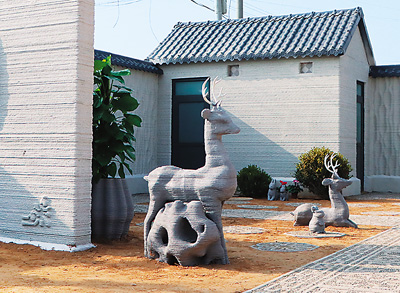
Photo shows 3D-printed sculptures in Gucheng county, northern China's Hebei Province. (People's Daily Overseas Edition/Kang Pu)
"From the initial design stage, we gave full consideration to functions like heat insulation and sound insulation, as well as requirements for earthquake and disaster resistance," said Professor Wang Hailong, who is also the director of the Institute of Intelligent Construction and Engineering Management at Zhejiang University.
“We also used low-carbon concrete made from solid waste, making it even more environmentally friendly,” Wang added.
According to Wang, the team has been dedicated to research on digital construction technology since 2013. So far, they have obtained over 30 domestic and foreign invention patents on 3D printing materials, equipment, structure, and construction methods, and their equipment and technologies have been exported abroad.
“The construction cost of the courtyard is about 300,000 yuan (about $42,238.7), which is close to that of a common brick-concrete house in rural areas,” said Zhang Yan'an, deputy head of the bureau of agriculture and rural affairs of Gucheng county.
“As rural areas often face a labor shortage in terms of building houses, 3D printing provides new opportunities for the construction of a beautiful countryside,” Zhang added.
Printing bones: 3D printing revolutionizing medicine
In a room at the 3D Printing Consultation Center of the Shanghai Ninth People's Hospital, affiliated with Shanghai Jiao Tong University School of Medicine, various 3D-printed models of human bones and joints are displayed on shelves.
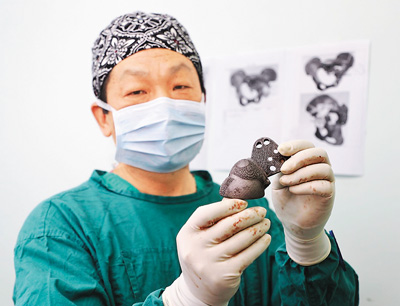
Hao Yongqiang, a chief physician at the Department of Orthopedics of the Shanghai Ninth People's Hospital, affiliated with Shanghai Jiao Tong University School of Medicine, showcases a 3D-printed personalized pelvic prosthesis he made. (Photo courtesy of the interviewee)
“The use of models for surgical design is the first level medical application of 3D printing. With this model, the size of the tumor, its location, and its relationship with surrounding organs, blood vessels, nerves, and so on are clearly visible, which not only reduces surgery time but also helps young doctors grow faster,” said Hao Yongqiang, a chief physician at the hospital's Department of Orthopedics.
The application of 3D printing has enabled precise treatment in orthopedic surgery, while 3D bio-printed active tissues or organs represent the highest level of 3D printing for medical applications.
Two years ago, a 16-year-old female patient was diagnosed as suffering from a tumor in the proximal left tibia. Hao used 3D bio-printed personalized active bone scaffolds to repair her bone defects, the first use of this technology pioneered by Chinese scientists. As a result, only a month or so later the patient was back in school moving freely, even participating in physical education classes.
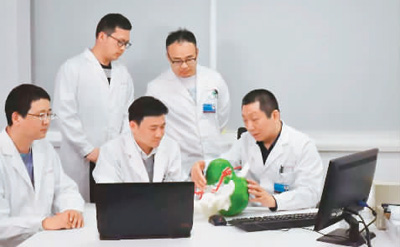
Hao Yongqiang (1st R), a chief physician at the Department of Orthopedics of the Shanghai Ninth People's Hospital, affiliated with Shanghai Jiao Tong University School of Medicine, discusses the design plan for a 3D-printed personalized pelvic prosthesis with engineers of his team. (Photo courtesy of the interviewee)
With 35 years of medical experience, Hao has helped countless patients benefit from 3D printing technology.
Hao serves as director of the Medical 3D Printing Innovation Research Center of Shanghai Jiao Tong University School of Medicine, which was established in 2016. So far, nearly 100 medical 3D printing sub-centers have been established in 28 provinces across China.
DIY ceramics: How 3D printing is improving creativity
In ancient times, the design and creation of porcelain pieces was a multiple month process reserved only for experts. Today, people at home with the right materials can produce ceramics in 15 minutes.
This is thanks to Liu Wenqiang, founder of Jinan ChenKun Intelligent Technology Co., Ltd. The company, located in east China's Shandong Province, has developed a series of ceramic 3D printers suitable for various uses.
"We have products suitable for ordinary consumers as well as professionals and companies," said Liu.
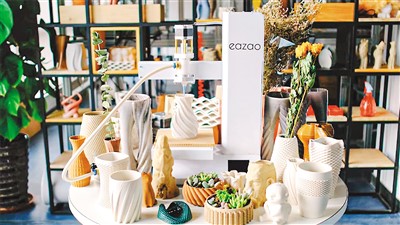
Photo shows a ceramic 3D printer developed by Jinan ChenKun Intelligent Technology Co., Ltd. and 3D-printed ceramics. (Photo courtesy of the interviewee)
"Ceramic 3D printers greatly reduce the cost of artistic creation and artistic experience," Liu added.
He stated that 3D printing can help users overcome the limits of traditional handmade ceramic techniques to create more complex and diversified shapes.
Jill Taylor, a 60-plus-year-old American, is one of the people who has enjoyed the freedom of creativity provided by Liu’s 3D printers. An avid pottery lover, Taylor found that her old age made it difficult for her hands to create the pieces her mind envisioned. With the use of the company’s products, she was able to print the intricate pieces needed to finish her works, which she proudly shared on social media.
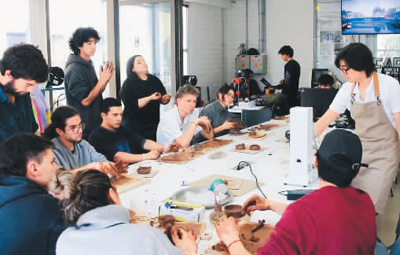
Ceramics enthusiasts experience a ceramic 3D printer developed by Jinan ChenKun Intelligent Technology Co., Ltd. at a ceramics course offered by overseas craftsmen. (Photo courtesy of the interviewee)
In addition to ceramics, 3D printing has been applied in more and more areas of the cultural and creative field, including figurines, ship models, architectural models, statues, and toys.
According to reliable data, more than 1.35 million units of consumer 3D printers were sold in China in 2022, a 14.4-fold increase over 2017.
"Most of our users are from overseas," Liu said, “I hope that the company's products can enter more families and allow people to enjoy the fun of DIY more conveniently.”
Photos
Related Stories
- 3D printing construction company empowers village development in Xizang
- China plans to test use of 3D printing tech for construction on moon
- In pics: 3D-printed statue replica displayed in Qingdao
- Chinese researchers gain ground in 3D-printed hydrogels
- 3D printing speeds up production of missiles
- Researchers propose 3D printing approach to develop high-strength titanium alloy
Copyright © 2024 People's Daily Online. All Rights Reserved.









